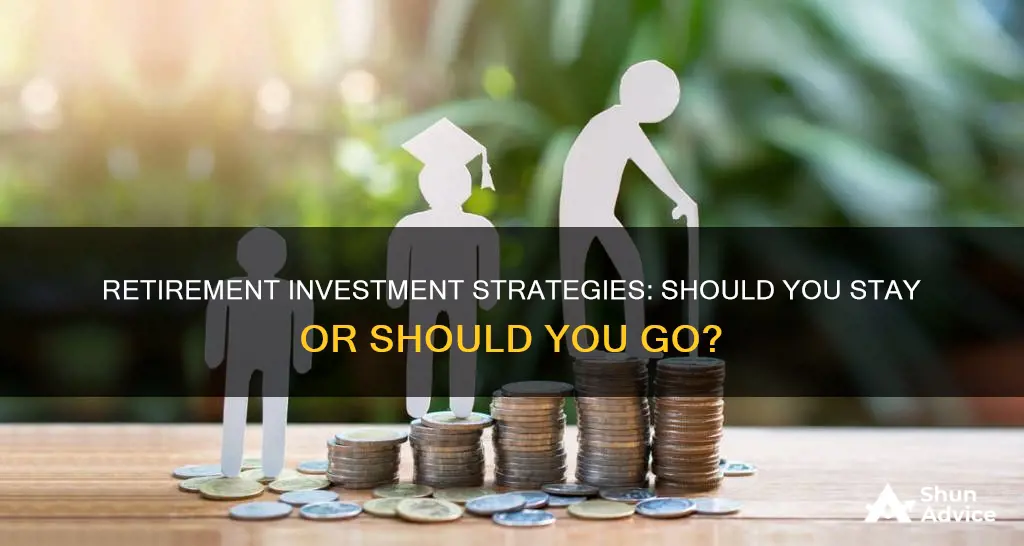
As you approach retirement, you may be wondering whether you should change your investment portfolio. The short answer is that it depends on your circumstances. While it's generally advised to avoid making changes, there are certain conditions when it's okay to adjust your investments.
Firstly, it's crucial to understand the transition from accumulating assets to spending them down during retirement. This is a critical financial phase, as investment mistakes can lead to running out of money or needing to re-enter the workforce. Therefore, it's essential to carefully consider your portfolio withdrawal rate and how it translates to risk tolerance.
Secondly, while stocks provide the most significant long-term growth potential, they also carry higher risks. As you get older, it's recommended to scale back on stocks and increase your holdings in bonds, which offer lower returns but less volatility. Additionally, consider your risk tolerance, age, and the amount you need to retire when deciding on investment allocations.
Lastly, while it's tempting to modify your investments during market downturns, it's often better to leave them untouched. Your money has the potential to grow over time if you ride out the fluctuations. However, if there are changes in your investment goals' time horizons or significant life events, it may be prudent to reassess your portfolio.
What You'll Learn

Shift from stocks to bonds as you age
As you get older, you'll likely want to shift your asset allocation towards a more conservative asset allocation, with a higher percentage allocated to bonds and cash. This is because, as retirement age approaches, the point at which you'll need to tap your savings draws near, and you may want to shift your retirement asset allocation into less risky assets.
The Classic Recommendation for Asset Allocation
The classic recommendation for asset allocation is to subtract your age from 100 to find out how much you should allocate towards stocks. The basic premise is that we become risk-averse as we age given we have less of an ability to generate income. We also don't want to spend our older years working. We are willing to trade lower returns for higher certainty.
The New Life Asset Allocation Model
The New Life asset allocation recommendation is to subtract your age by 120 to figure out how much of your portfolio should be allocated towards stocks. Studies show we are living longer due to advancements in science and better awareness about how we should eat. Given stocks have shown to outperform bonds over the long run, we need a greater allocation towards stocks to take care of our longer lives. Our risk tolerance still decreases as we get older, just at a later stage. While in retirement, ideally, returns are conservative, demonstrate low volatility, and generate steady passive income.
The Survival Asset Allocation Model
The Survival Asset Allocation model is for those who are risk-averse. The 50/50 asset allocation increases the chances your overall portfolio will outperform during a stock market collapse because your bonds will be increasing in value as investors flee towards safety. Bonds can also rise when stocks rise. During the 2008 Global Financial Crisis, a bond index fund only fell by about 1.5%, while stocks declined by 38%. The worst year ever for bonds was in 1994 when bonds fell 2.9%.
The Nothing-To-Lose Asset Allocation Model
Given stocks have shown to outperform bonds since 1926, the Nothing-To-Lose Asset Allocation model is for those who want to go all-in on stocks. If you have a long enough time horizon, this strategy might suit you well.
The Financial Samurai Asset Allocation Model
The Financial Samurai model is a hybrid between the Nothing-To-Lose model and the New Life model. I believe stocks will outperform bonds over the long run, but we'll see continued volatility over our lifetimes. I also believe this is the most proper asset allocation if you consistently read my site.
The Right Asset Allocation Depends on Your Risk-Tolerance
By providing five different asset allocation models, I hope you are able to identify one that fits your needs and risk tolerance. Don't let anybody force you into an uncomfortable situation.
Ideally, your asset allocation should let you sleep well at night and wake up every morning with vigor. When it comes to investing, you need to calculate your existing investment exposure and invest accordingly.
Unleashing Zelle Pay: A Guide to Investing in the Popular Payment Platform
You may want to see also

Up your contributions as your income grows
As your income grows, it is advisable to increase your contributions to your retirement savings. This strategy can have a snowball effect, leading to a more substantial account balance in the future.
Retirement accounts, such as 401(k)s or IRAs, are a great way to boost your savings over time. It is recommended to increase your contribution rate by at least 1% annually. An auto-escalation plan for your 401(k) can be beneficial in this regard, as it automatically increases your contributions without requiring much additional effort.
Additionally, consider taking advantage of "catch-up" contributions if you are nearing retirement age (50 or older). This allows you to stash away additional funds for your golden years.
Making extra contributions to your retirement savings can also provide tax benefits. Pre-tax retirement accounts, such as employer-sponsored 401(k)s or traditional IRAs, allow you to reduce your taxable income. Your contributions grow tax-deferred, although you will need to pay income tax upon withdrawal during retirement.
If you are a high-income earner, extra payments into your superannuation fund may help reduce your tax liability. Super contributions are typically taxed at a lower rate than regular income. However, be mindful of contribution caps to avoid paying extra tax.
It is important to regularly review your retirement investments to ensure they align with your financial goals. Consult a financial advisor or representative to discuss your specific circumstances and make informed decisions.
Gladstone Investment: Unlocking Monthly Dividend Potential
You may want to see also

Choose a target-based fund or a risk-based portfolio
When it comes to retirement investments, there are two main options to consider: target-based funds and risk-based portfolios. Here are some detailed paragraphs on each option to help you make an informed decision.
Target-Based Funds
Target-date funds are a popular choice for investors saving for retirement. These funds are designed to maximise returns by a specific date, usually the investor's anticipated retirement year. The funds periodically rebalance their asset allocation, gradually shifting from riskier investments towards more conservative choices as the target date approaches. This makes them a good option for those who want a more hands-off approach to their retirement investments. Target-date funds are often chosen by younger investors who have a longer time horizon and can take on more risk. As the target date nears, the focus shifts to capital preservation.
One of the advantages of target-date funds is their simplicity. They are structured to automatically rebalance your portfolio over time, so you don't have to actively manage your investments. This can be a convenient, "set it and forget it" approach for those who don't want to constantly monitor and adjust their portfolio. Additionally, target-date funds offer exposure to a variety of markets and provide a selection of asset allocation options.
However, there are also some disadvantages to consider. Target-date funds may have higher fees compared to other passive investments, as they are technically funds of funds, investing in other mutual funds or exchange-traded funds (ETFs). The specific investments and strategies used by target-date funds can vary, so it's important to do your research and choose a fund that aligns with your risk tolerance and investment goals. Additionally, target-date funds may not offer much flexibility to accommodate changing investor goals and needs.
Risk-Based Portfolios
Risk-based portfolios, also known as target-risk funds, are another option for retirement investments. Unlike target-date funds, these portfolios are based on your risk tolerance rather than a specific target date. They typically offer three groups to choose from: conservative, aggressive, or moderate risk. This can be a good option for those who want more control over the level of risk in their portfolio and may not have a clear retirement date in mind.
One advantage of risk-based portfolios is that they offer more flexibility. If your risk tolerance changes over time, you have the option to switch to a different risk level. Additionally, risk-based portfolios may provide more opportunities for active management, allowing you to react to market trends and make adjustments as needed.
However, one of the disadvantages of risk-based portfolios is that they require more active involvement from the investor. You need to regularly monitor and adjust your portfolio to ensure it aligns with your risk tolerance and investment goals. Additionally, the fees associated with risk-based portfolios can vary, and you may need to pay higher expenses for actively managed accounts.
In conclusion, both target-based funds and risk-based portfolios have their own advantages and disadvantages. Target-based funds offer a more hands-off approach with automatic rebalancing, while risk-based portfolios provide more flexibility and control over the level of risk. It's important to consider your own financial situation, risk tolerance, and investment goals when deciding which option is right for you.
The Great Debate: Home Sweet Home or Loan Freedom?
You may want to see also

Consider socially responsible investing
If you want to put your money into causes you care about, socially responsible investing (SRI) is a good option. This strategy prioritizes financial return with the caveat that the money is invested to fuel positive change in three key areas: environmental, social, and corporate governance (ESG).
According to KPMG, 37% of American consumers consider environmental sustainability when making a purchase, and 33% also consider social responsibility. These numbers are even more dramatic when it comes to investing. A 2022 study estimated that nearly 9 out of every 10 investors cared about deploying socially responsible strategies as they plan for retirement.
There are several ways to get started with socially responsible investing. You can review the 17 Sustainable Development Goals set by the United Nations and decide which companies strive to achieve the goals that matter most to you. Many funds or companies will have a stated commitment to furthering certain environmental or social causes, such as racial equality, clean food and energy, affordable housing, or animal rights.
You can also use resources like As You Sow, which allows you to plug in the ticker of a fund to review how it performs across a variety of social impact measures, like fossil fuel usage or gender equality. Another option is to find a financial advisor with an ESG background to guide you.
If you have a retirement account through your employer, you likely already have socially responsible investing options available to you. If not, you can ask those who handle the company's benefits about adding an option.
Some examples of socially responsible funds include iShares ESG Aware MSCI USA ETF, iShares Global Clean Energy ETF, and Putnam Sustainable Leaders.
Oil Investment: Why the Appeal?
You may want to see also

Update your beneficiaries after major life events
It is important to update your beneficiaries after major life events to ensure that your assets are distributed according to your wishes. Here are some key reasons why you should review and update your beneficiaries:
- Marriage or Divorce: The presence or absence of a spouse can significantly impact how your assets will be distributed. In the case of marriage, you may want your spouse to be the primary beneficiary. If it is a second marriage, you may also want to ensure that your children from a previous marriage are included as beneficiaries. In the event of a divorce, you will typically want to remove your former spouse as the beneficiary of your estate, retirement accounts, and insurance policies.
- Birth or Adoption of a Child: When you have a child or adopt one, you may want to include them as a beneficiary. In the case of adoption, foster, or stepchildren, be sure to name them explicitly in your estate plan to ensure they are legally recognised as beneficiaries.
- Death of a Beneficiary: If one of your named beneficiaries passes away, you will need to update your designations. Review your estate plan and make any necessary changes to ensure your wishes are accurately reflected.
- Change in Financial Circumstances: If you experience a significant change in your finances, such as receiving an inheritance or starting a business, you should update your beneficiaries. This ensures that any new financial accounts or assets are appropriately included in your estate plan and distributed to the intended beneficiaries.
Remember, beneficiary designations are separate from the provisions in your will or trust. Therefore, it is crucial to periodically review and update your beneficiary designations to avoid any discrepancies or outdated information. By staying vigilant about updating your beneficiaries after major life events, you can ensure that your assets are distributed according to your wishes and provide peace of mind for yourself and your loved ones.
Zack's Investment Recommendations: Current Insights
You may want to see also
Frequently asked questions
Yes, you should. As you age, your tolerance for risk decreases, so you should scale back on the percentage of stocks in your portfolio over time and increase the percentage of your holdings in bonds.
Keeping regular tabs on your retirement investments is crucial to ensuring they still align with your goals. It is recommended to check in on your investments at least once a year.
As you advance in your career and earn more, you should consider boosting the amount you put into retirement accounts. It is recommended to raise your contribution rate by at least 1% every year.







